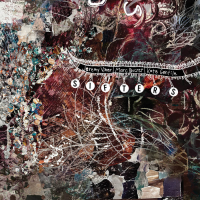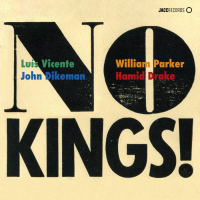Home » Jazz Articles » Album Review » Grateful Dead: Grateful Dead (Skull & Roses)
Grateful Dead: Grateful Dead (Skull & Roses)
Repeats of some material only give the illusion this milestone vault exhumation is of lesser depth and dimension than its predecessors. On the contrary, it foreshadows the wealth of originals within Europe '72 (Warner Bros., 1972), with selections the late band lyricist Robert Hunter saw as part of an ostensible successor to the aforementioned pair of studio efforts. For example, this opener of "Bertha" is perhaps the most ebullient piece of music guitarist Jerry Garcia and Hunter ever composed together, and its whimsical tale married to peppy melody, the hop/skip/jump of rhythm decorated with vocal harmonies as tuneful as this band ever sang, is a perfect foil for the poignant drama that comprises this penultimate cut "Wharf Rat;" with its ringing guitar (and uncredited piano) chimes and lyrics so rife with cinematic detail of both people and places, it's surprising no one has made a movie of it.
Those two brilliant compositions are both played with the appropriate enthusiasm and grace, proof positive of the deserved collective self-confidence the Grateful Dead had developed by this time. The range of other selections, taken together with "Playing in the Band," effectively constitute a veritable primer on the vast self-composted canon of these psychedelic warriors. Yet, cover material peppers the song sequence too in the form of rhythm guitarist Bob Weir's wry rendering of Merle Haggard's "Mama Tried" and keyboardist/harpist/vocalist Ron McKernan's (a/k/a 'Pigpen) gruff growl on blues icon Jimmy Reed's "Big Boss Man," those along with Chuck Berry's "Johnny B. Goode," a perennial favorite source of songs for these musicians synonymous with San Francisco.
Such comparatively quick takes on those tunes counterpoint the most exploratory likes of "The Other One." Yet the latter, an improvisational staple for the group, times out at only (!) some eighteen minutes-plus even, with drummer Bill Kreutzmann's solo; launched as usual with a bomb from bassist Phil Lesh, the brevity of the latter is indicative of the cut's relative overall economy. The same is true of the "Goin' Down the Road Feeling Bad:" one of a few de rigueur closings for the Dead during its thirty-years history, the traditional is sandwiched between two intervals of Buddy Holly's "Not Fade Away." It's one of the multiple reminders within this work of the way this ensemble could dramatically yet subtly alter familiar elements of its performances.
Likewise, this second half of the expanded title proffers what is essentially an earlier incarnation of the Grateful Dead as a dance band par excellence inclined to frequent forays through interstellar space and time. Such travels nevertheless appear side-by-side with earnest explorations of deeply human emotion such as this ten-minutes plus of Garcia's impassioned singing on "Sing Me Back Home," composed by the same aforementioned country author of "Okie From Muskogee."
Again, the stretching out complements the terse approach, too, on the previously-unreleased ten tracks from Fillmore West, as with those original eleven amassed ones from various other sources. The (Young) Rascals' "Good Lovin'"clocks in at seventeen minutes plus, while this take on "The Other One," prefaced by "Cryptical Envelopment" and integrating Kreutzmann's ever-so-limber workout on his kit, is of approximately twenty-four minutes duration within the total hour of complementary content.
Similarly concise and to the point is Gary Lambert's essay writing the twelve-page booklet. Next to some archetypal action photos, the prose composed by this former employee of the late impresario Bill Graham and a long-term contributor to the Grateful Dead's official newsletter is both clear-eyed and passionate, while his grasp of knowledge comes across as effortlessly as his writing in following the chronological sequence of steps leading to this halcyon project.
In its enlarged form, Grateful Dead captures its subject with clarity and accuracy. Known colloquially for years as Skull & Roses, based on the the striking artwork of Alton Kelley—taken from an illustration in an old edition of 'The Rubaiyat of Omar Khayyam,' which producer David Lemieux and his curating team wisely decided not to tamper with—the eponymous title was assigned as something of a compromise between the group and the record company: the prank-minded former had a more graphic, near-epithet name in mind.
No matter, though, because the 50th Anniversary Expanded Edition of Skullf*#k functions even more completely as originally intended, a durable refresher for fans of longstanding as well as an almost ideal introduction to the band for those not so anointed.
Track Listing
CD 1 - Bertha; Mama Tried; Big Railroad Blues; Playing in the Band; The Other One; Me & My Uncle; Big Boss Man; Me & Bobby McGee; Johnny B. Goode; Wharf Rat; Not Fade Away / Goin’ Down the Road Feeling Bad. CD 2: Good Lovin'; Sing Me Back Home; Mama Tried; Cryptical Envelopment/Drums/The Other One; Big Boss Man; Not Fade Away/Goin' Down the Road Feeling Bad/Not Fade Away.
Personnel
Grateful Dead
band / ensemble / orchestraJerry Garcia
guitar, electricBob Weir
guitar and vocalsPhil Lesh
bass, electricBill Kreutzmann
drumsRon McKernan
vocalsMerl Saunders
keyboardsAdditional Instrumentation
Jerry Garcia: vocals; Bob Weir: vocals; Phil Lesh: vocals; Ron McKernan: organ, harmonica; Bill Kreutzmann: drums.
Album information
Title: Grateful Dead (Skull & Roses) | Year Released: 2021 | Record Label: Rhino
Tags
About Grateful Dead
Instrument: Band / ensemble / orchestra
PREVIOUS / NEXT
Support All About Jazz
 All About Jazz has been a pillar of jazz since 1995, championing it as an art form and, more importantly, supporting the musicians who make it. Our enduring commitment has made "AAJ" one of the most culturally important websites of its kind, read by hundreds of thousands of fans, musicians and industry figures every month.
All About Jazz has been a pillar of jazz since 1995, championing it as an art form and, more importantly, supporting the musicians who make it. Our enduring commitment has made "AAJ" one of the most culturally important websites of its kind, read by hundreds of thousands of fans, musicians and industry figures every month.

























